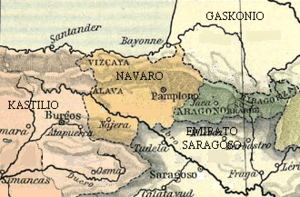War of the Three Sanchos facts for kids
Quick facts for kids War of the Three Sanchos |
|||||||||
|---|---|---|---|---|---|---|---|---|---|

|
|||||||||
|
|||||||||
| Belligerents | |||||||||
| Commanders and leaders | |||||||||
The War of the Three Sanchos (which means Guerra de los Tres Sanchos in Spanish) was a short war in Spain. It happened between 1065 and 1067. The war involved three kingdoms: Castile, Navarre, and Aragon.
These kingdoms were all ruled by kings named Sancho. They were cousins and part of the Jiménez dynasty family. The kings were Sancho II of Castile, Sancho IV of Navarre, and Sancho Ramírez of Aragon. All three were grandsons of a powerful king known as Sancho the Great.
Contents
Why Did the War Start?
The main reason for the war was old disagreements about land. These problems started after Sancho the Great's kingdom was divided in 1035. At first, Navarre was stronger than Castile and Aragon. But by 1065, Navarre had become a "vassal" of Castile. This means Navarre had to show loyalty to Castile.
In 1065, Ferdinand the Great, the king of Castile, died. His kingdom was then split among his sons. His oldest son, Sancho, became king of Castile. This new King Sancho II of Castile wanted more land. He especially wanted areas called Bureba and Alta Rioja.
Disputed Lands and Old Promises
King Ferdinand had helped take these lands back from the Caliphate, a Muslim empire. But then he gave them to his older brother, García Sánchez III of Navarre. García Sánchez III was the father of Sancho IV of Navarre. So, Sancho II of Castile felt these lands should belong to Castile.
Key Events and Battles
The war began with small attacks along the borders. Soon, Sancho IV of Navarre asked for help from Sancho Ramírez of Aragon. Most of the fighting happened in the areas of Burgos and La Rioja.
Castile also wanted to join the Reconquista. This was a long effort to take back land from Muslim rulers in Spain. The division of Ferdinand's kingdom had made it harder for Castile to do this.
El Cid's Role in the Conflict
Sancho II of Castile also tried to control the Muslim kingdom of Zaragoza. This kingdom owed him parias, which were payments or tributes. During one of these campaigns, a famous knight named Rodrigo Díaz de Vivar fought. He was King Sancho's main commander.
Rodrigo Díaz de Vivar defeated the Navarrese commander, Jimeno Garcés. Because of this victory, Rodrigo earned the nickname campi doctor. This means "master of the battlefield." Later, he became known as el Campeador, or "the Champion," and is famous in Spanish literature as El Cid.
Counterattack and Outcome
Between August and September of 1067, Sancho Ramírez of Aragon led a counterattack against Castile. Historical records disagree about who won this part of the war. Some say Navarre and Aragon won a big victory at Viana. Others say Sancho II of Castile won.
Most historians today believe Sancho II of Castile was in a strong position. He was able to officially define the area of the only bishopric (church district) in Castile. This shows he had power and control.
End of the War
The war ended in 1067. Castile took back Álava, the Montes de Oca, and Pancorvo. They also got Bureba and Alta Rioja. However, the conflict stopped because Ferdinand's widow, Sancha of León, died. This event led to new conflicts between Ferdinand's sons.
The main problem of who owned the border lands was finally solved in 1076. This happened when Sancho IV of Navarre was killed by his own brother. His kingdom was then divided. Sancho Ramírez of Aragon became king of Navarre (as Sancho V). The disputed lands went to Alfonso VI of León and Castile.
See also
 In Spanish: Guerra de los Tres Sanchos para niños
In Spanish: Guerra de los Tres Sanchos para niños

